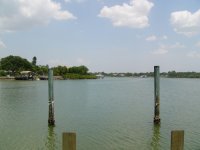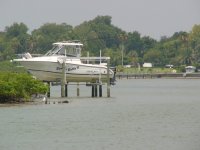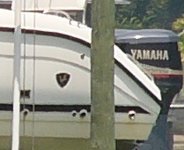I'll elaborate a bit on the 15x50. Firstly, resolution. Tripod mounted and IS off, my pair through a 3x booster resolves 1.46 arc seconds through the right barrel and 1.3 arcsecs through the left. with stabilization engaged (still tripod mounted) the resolution drops slightly, to 1.64 arcsec. However, since with the IS on the resolution varies somewhat as the vari-angle prisms do their job, the image is at times softer, but this 1.64 was resolvable. Now, the best figures I have measured for traditional binoculars have been 1.84 arcsec for 10x42 Zeiss and Nikon models. If you multiply these figures by the magnification, you get 18-25 arcseconds as what your visual acuity would have to be before the binocular would be the limiting factor. In real life, human eyes can resolve at best some 30 arcseconds, with 60 considered normal 20/20 vision. To make matters more complicated, however, I have found that in order to appear totally satisfyingly sharp, a binocular has to have resolution about twice as good as what my eye can use. The best traditional binoculars do this, but the Canon not quite. Compared to top-class traditional binoculars, it does look slightly less sharp. It is also not as bright, although it is not too dim by any means. The 15x50's light transmission was recently lab measured by Kameralehti in Finland as 78%, same as Leica Trinovid BN 8x42. The best figure, 89%, was Zeiss 7x42 classic, with Swaro EL being just over 81%, and Victory II 8x40 88%. However, with the combination of high magnification and IS, they show more detail under any light conditions, up to near-darkness, than any of the 8-10x42-50 binoculars I have compared them to, and that is a good many. Kameralehti got dismal resolution figures for their Canon, so I suspect they must have had a true lemon there. Contrast is good but not superb, roughly comparable to pre-Ultravid Leicas. There is a rather prominent yellow cast to the image, which I suspect is deliberate since it seems to be largely introduced by the flat filters/dust seal glasses in front of the moving objective lens assemblies. This has a deep blue-purple coating, and I think it is there to increase contrast in mist, rain and snow as well as over very large distances, as it cuts scattered ultraviolet-blue wawelengths. Anyway, in gray conditions as well as over snowscapes, the Canon has excellent contrast. The field is exceptionally flat, with measured resolution dropping only about half to the very edge. Stars remain points virtually over the entire field. So, as a 15x50 binocular without stabilization, I would rate the Canon as very successful overall, and it is perfectly usable should you run out of power.
As an answer to the question of whether birds are enjoyable to view through the Canon, yes. I enjoy viewing a bird and studying it's detail through them immensely. At close quarters such as watching warblers in nearby trees, it is like having a low-power scope with stereo vision and easy, quick aiming. One example of their difference to normal binoculars. I was recently testing a top-class 8x binocular at my summer place. Looking over the lake at the yard of a house some 2 kilometers away with the 8x hand held, I noticed that there was some structure on the lawn, but could not begin to tell what it was except that it was colorfull and about the size of a small doghouse. Switching to the Canon and pressing the stabilizer, I immediately saw that it was an old wooden wheelbarrow which had flowers planted in it. Similar things happen all the time with the Canon.
Why doesn't everyone own them, then? Firstly, because the IS does tricks on you. The more the vari-angle prisms are compensating, the more they must bend the light, the more they introduce what is called "wedge distortion," whereby image softens and chromatic aberration (which is very low in the unstabilized mode) increases. Since the status of the prisms varies constantly, so does the absolute image quality. Since the image does not shake, this change of quality is much more easily perceived than it would be if the binocular would shake like normal binoculars do. If you don't let this bother you and just keep looking, the image usually centers and sharpens in a few seconds, but if you are following fast-flying birds at closer ranges, it is often better to have IS off. When viewing stars, these prism artifacts are pretty visible with the stars changing shape and size until you manage to hold the binocular still and the image settles. With normal binoculars hand held, though, you tend to see a wild dance of points of light instead! Also, as I stated in my earlier post, there seems to be more unit-to-unit quality variations than would be acceptable. "Seasickness" is something that you might experience initially, but as soon as my brain got used to the image behavior, it went away never to come back.
Another problem is that the eyepiece design seems to be super-critical for exactly right placement of the eye to the exit pupil. This means that interpupillary adjustment has to be just right. If your eyes are even slightly off, image is not as sharp. I have indexed my bins for my interpupillary setting, but even so, every time I let someone else mess with the binocular, it takes me considerable time and effort to find just the right setting again. Once I have it nailed, the view is easy and relaxed, and a full day of use tires my eyes and brain less than with normal binoculars. If you don't know what to expect or what to do, or simply don't have the patience, you will see a splendid image only by chance. The eyecups are also awful. They are sloppy and huge, and better left downturned at all times.
There is a tripod mounting thread in the bottom at the center of gravity point, and I often use a Finnstick attached to it so I can hold my hands at waist level.
Thus far, they have survived everything but a one-foot drop, objectives first, to a stone floor. That required a trip to the binocular doctor, who re-located the right barrel's objective lens cell which had slipped on its focus shaft so that I needed all the diopter adjustment range there was although normally I use -0.5. They have been with me in rain and on a sailing trip. After the sailing trip, the first day out with freezing temperatures they fogged up inside. My bin doctor opened them up and filled them with nitrogen, and they've been fine since. Image stabilization seems to work in any temperature - the coldest I have used them has been around -20 C. Focus also remains beautifully smooth (but slow) in any temperature.
They absolutely need a wide neoprene strap (mine comes from Fujinon FMTRCSX) and a proper eyepiece rainguard (same source, only one I've seen that fits).
In summary, while far from perfect, the Canon is in many ways a superior product and, if you give it time and get a goot unit, highly addictive.
Kimmo








